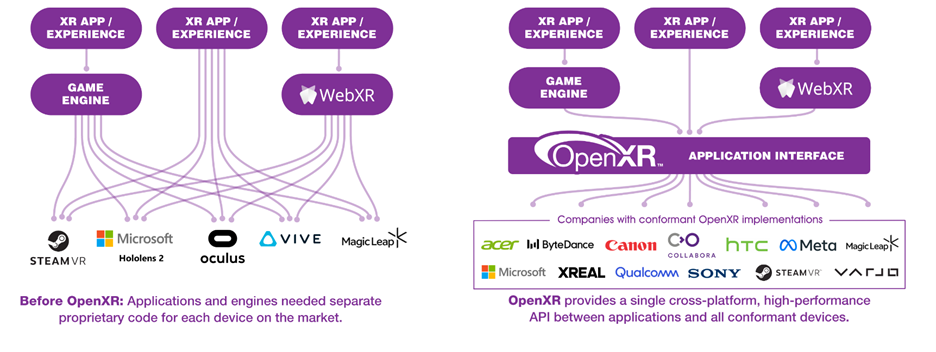OpenXR 1.1 is the first core specification update designed to streamline cross-platform XR development. It consolidates multiple OpenXR extensions into the core API, enhancing programming convenience and consistency. Khronos says OpenXR 1.1 empowers developers to focus on creating XR applications without compatibility issues. It reflects the collective dedication of the OpenXR Working Group and the extended XR community to refine and advance the standard to meet the evolving ecosystem’s dynamic requirements.

What do we think? This update reinforces Khronos’s history of reducing technical obstacles in creating portable, immersive experiences. In the XR realm, Khronos has transitioned from exploratory investigations to the consolidation of the relevant specifications. In the process, they nearly doubled the number of members that have dropped their proprietary APIs in favor of a robust and universal open API—the Khronos effect.
Khronos’ OpenXR 1.1 spec to aid in cross-platform XR development
Khronos announced the availability of its OpenXR 1.1 specification. This release evolves the OpenXR open API standard for high-performance, cross-platform access to VR, AR, and mixed reality (MR) platforms and devices—collectively known as XR.
OpenXR 1.1 consolidates widely used API extensions into the core specification to reduce fragmentation and adds new functionality to streamline the development of more powerful and efficient XR applications.
In particular, OpenXR 1.1 consolidates multiple vendor extensions for key functionality to reduce differences in application code across multiple platforms while remaining flexible and extensible. The OpenXR Working Group will manage a pipeline of extensions to develop and seek feedback on new functionality, while integrating existing technology into the core specification, all with the goal of providing developers with cross-platform XR capabilities.

Khronos claims most major XR platforms have transitioned to using OpenXR to expose current and future device capabilities. Vendors with conformant OpenXR implementations include Acer, ByteDance, Canon, HTC, Magic Leap, Meta, Microsoft, Sony, XReal, Qualcomm, Valve, Varjo, and Collabora’s Monado open-source runtime. OpenXR is also supported by all the major game and rendering engines, including Autodesk VRed, Blender, Unreal Engine, Godot, StereoKit, Nvidia’s Omniverse, and Unity.
The OpenXR 1.1 specification and extensions promoted to the OpenXR 1.1 core specification can be found on the OpenXR Khronos website and on GitHub OpenXR Registry.
The OpenXR Conformance Test Suite (CTS) is available on GitHub and includes updates and enhancements for the functionality that has been integrated into the OpenXR 1.1 core specification, enabling consistent implementation across all conformant platforms.
In conclusion, the OpenXR Working Group welcomes and encourages feedback from the XR developer community on their experience with OpenXR and to help prioritize future developments on the OpenXR road map. For example, the Working Group is exploring multiple areas, such as extending hand tracking to include full-body tracking and enhanced handling of spatial entities to provide standardized methods to interact with the user’s environment in advanced spatial computing applications.